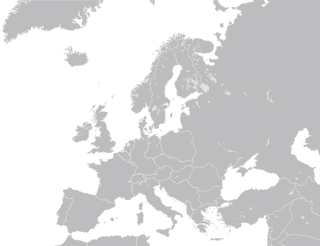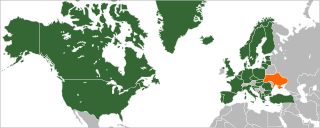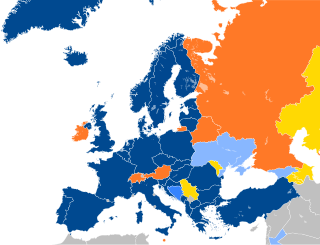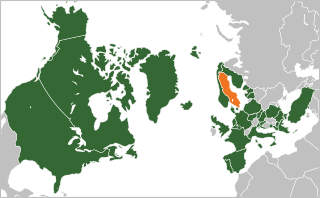
The foreign relations of North Macedonia since its independence in 1991 have been characterized by the country's efforts to gain membership in international organizations such as NATO and the European Union and to gain international recognition under its previous constitutional name, overshadowed by a long-standing, dead-locked dispute with neighboring Greece. Greek objections to the country's name had led to it being admitted to the United Nations and several other international fora only under the provisional designation Former Yugoslav Republic of Macedonia until its official and erga omnes renaming to North Macedonia, a name under which it is now universally recognised.

The North Atlantic Treaty Organization, also called the North Atlantic Alliance, is an intergovernmental military alliance of 32 member states—30 European and 2 North American. Established in the aftermath of World War II, the organization implements the North Atlantic Treaty, signed in Washington, D.C., on 4 April 1949. NATO is a collective security system: its independent member states agree to defend each other against attacks by third parties. During the Cold War, NATO operated as a check on the threat posed by the Soviet Union. The alliance remained in place after the dissolution of the Soviet Union and the Warsaw Pact, and has been involved in military operations in the Balkans, the Middle East, South Asia and Africa. The organization's motto is animus in consulendo liber. The organization's strategic concepts include deterrence.

Star Alliance is the world's first global airline alliance. Founded on 14 May 1997, it is headquartered on the grounds of Frankfurt Airport in Frankfurt, Germany, with a subsidiary management company in Singapore. Star Alliance is also the world's largest airline alliance by market share as of April 2024, with 17.4% of market share, compared to 13.7% of SkyTeam and 11.9% of Oneworld.
Oneworld is a global airline alliance consisting of 13 member airlines. It was founded on 1 February 1999. The alliance's stated objective is to be the first choice airline alliance for the world's frequent international travellers. Its headquarters have been located in Fort Worth, Texas since December 2022.

The Supreme Headquarters Allied Powers Europe (SHAPE) is the military headquarters of the North Atlantic Treaty Organization's (NATO) Allied Command Operations (ACO) that commands all NATO operations worldwide. SHAPE is situated in the village of Casteau, near Mons, Belgium.

The flag of NATO consists of a dark blue field charged with a white compass rose emblem, with four white lines radiating from the four cardinal directions. Adopted three years after the creation of NATO, it has been the flag of NATO since October 14, 1953. The blue color symbolizes the Atlantic Ocean, while the circle stands for unity.

The Supreme Allied Commander Atlantic (SACLANT) was one of two supreme commanders of the North Atlantic Treaty Organisation (NATO), the other being the Supreme Allied Commander Europe (SACEUR). The SACLANT led Allied Command Atlantic was based at Norfolk, Virginia. The entire command was routinely referred to as 'SACLANT'.

The Chair of the NATO Military Committee (CMC) is the head of the NATO Military Committee, which advises the North Atlantic Council (NAC) on military policy and strategy. The CMC is the senior military spokesperson of the 32-nation alliance and principal advisor to the Secretary General. The chair is one of the foremost officials of NATO, next to the Secretary General and the Supreme Allied Commander Europe. The CMC is assisted by the deputy chair, who advises the Deputy Secretary General and serves as the principal agent for coordination of nuclear, biological, and chemical matters for the Military Committee. Originally titled the Chairman, the post was redesignated in 2021 to reflect the gender-neutrality of the post.

NATO is a military alliance of thirty-two European and North American countries that constitutes a system of collective defense. The process of joining the alliance is governed by Article 10 of the North Atlantic Treaty, which allows for the invitation of "other European States" only and by subsequent agreements. Countries wishing to join must meet certain requirements and complete a multi-step process involving political dialog and military integration. The accession process is overseen by the North Atlantic Council, NATO's governing body. NATO was formed in 1949 with twelve founding members and has added new members ten times. The first additions were Greece and Turkey in 1952. In May 1955, West Germany joined NATO, which was one of the conditions agreed to as part of the end of the country's occupation by France, the United Kingdom, and the United States, prompting the Soviet Union to form its own collective security alliance later that month. Following the end of the Franco regime, newly democratic Spain chose to join NATO in 1982.

NATO is an international military alliance consisting of 32 member states from Europe and North America. It was established at the signing of the North Atlantic Treaty on 4 April 1949. Article 5 of the treaty states that if an armed attack occurs against one of the member states, it shall be considered an attack against all members, and other members shall assist the attacked member, with armed forces if necessary. Article 6 of the treaty limits the scope of Article 5 to the islands north of the Tropic of Cancer, the North American and European mainlands, the entirety of Turkey, and French Algeria, the last of which has been moot since July 1962. Thus, an attack on Hawaii, Puerto Rico, French Guiana, the Falkland Islands, Ceuta or Melilla, among other places, would not trigger an Article 5 response.

Relations between Ukraine and the North Atlantic Treaty Organization (NATO) started in 1991 following Ukraine's independence after the dissolution of the Soviet Union. Ukraine first joined NATO's Partnership for Peace program in 1994, later joining the Planning and Review Process in 1997 and the NATO-Ukraine Commission in 1998. Although Ukraine initially declared neutrality and non-alignment with military blocs after independence, it later signaled interest in eventual NATO membership. After Russia's annexation of Crimea and support for separatist forces in eastern Ukraine in 2014, Ukraine began actively pursuing NATO membership, formally declaring it a strategic policy objective in 2017.

The accession of Montenegro to the North Atlantic Treaty Organization, or NATO, took place on 5 June 2017. In December 2009, Montenegro was granted a Membership Action Plan, the final step in an application for membership in the organization. A formal invitation was issued by the alliance on 2 December 2015, with accession negotiations concluded with the signature by the Foreign Ministers of an Accession Protocol on 19 May 2016. Montenegro officially joined NATO on 5 June 2017.
The Structure of the North Atlantic Treaty Organization is complex and multi-faceted. The decision-making body is the North Atlantic Council (NAC), and the member state representatives also sit on the Defence Policy and Planning Committee (DPPC) and the Nuclear Planning Group (NPG). Below that the Secretary General of NATO directs the civilian International Staff, that is divided into administrative divisions, offices and other organizations. Also responsible to the NAC, DPPC, and NPG are a host of committees that supervise the various NATO logistics and standardisation agencies.

The NATO headquarters is the political and administrative center of the North Atlantic Treaty Organization (NATO). After previous locations in London and Paris, it has been headquartered in Brussels since 1967, in a complex in Haren, part of the City of Brussels, along the Boulevard Léopold III/Leopold III-laan.

NATO maintains foreign relations with many non-member countries across the globe. NATO runs a number of programs which provide a framework for the partnerships between itself and these non-member nations, typically based on that country's location. These include the Euro-Atlantic Partnership Council and the Partnership for Peace.

The Allied Maritime Command (MARCOM) is the central command of all NATO maritime forces and the Commander MARCOM is the prime maritime advisor to the Alliance. When directed by the Supreme Allied Commander Europe (SACEUR), it provides the core of the headquarters responsible for the conduct of maritime operations. The command is based at the Northwood Headquarters in Eastbury, Hertfordshire.

Finland has been a member of the North Atlantic Treaty Organization (NATO) since 4 April 2023.

The history of the North Atlantic Treaty Organization (NATO) begins in the immediate aftermath of World War II when British diplomacy set the stage to contain the Soviet Union and to stop the expansion of Soviet power in Europe. The United Kingdom and France signed, in 1947, the Treaty of Dunkirk, a defensive pact, which was expanded in 1948 with the Treaty of Brussels to add the three Benelux countries and committed them to collective defense against an armed attack for fifty years. The British worked with Washington to expand the alliance into NATO in 1949, adding the United States and Canada as well as Italy, Portugal, Norway, Denmark, and Iceland. Greece and Turkey joined in 1952, West Germany joined in 1955, Spain joined in 1982, Czech Republic, Hungary and Poland joined in 1999, Bulgaria, Estonia, Latvia, Lithuania, Romania, Slovakia, and Slovenia joined in 2004, Albania and Croatia joined in 2009, Montenegro joined in 2017, North Macedonia joined in 2020, Finland joined in 2023, and Sweden joined in 2024.

Withdrawal from the North Atlantic Treaty Organization (NATO) is the legal and political process whereby a member of the North Atlantic Treaty Organisation withdraws from the North Atlantic Treaty, and thus the country in question ceases to be a member of NATO. The formal process is stated in article 13 of the Treaty. This says that any country that wants to leave must send the United States a "notice of denunciation", which the U.S. would then pass on to the other Allies. After a one-year waiting period, the country that wants to leave would be out.

Sweden has been a member of the North Atlantic Treaty Organization (NATO) since 7 March 2024.



















